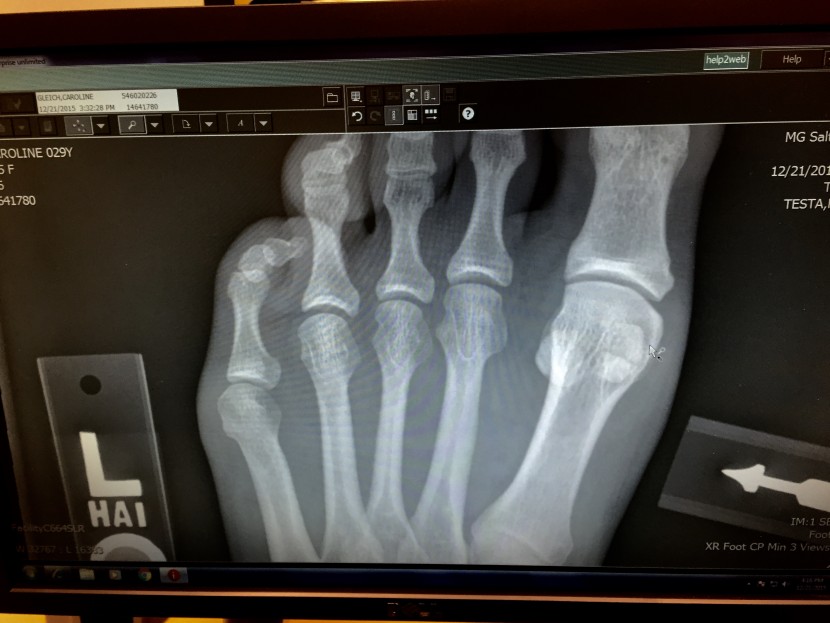
Swallowing Frogs: Impediments and Injuries in the Life of an Endurance Athlete
When I first began traveling internationally as part of my ski mountaineering career, my mom often would help me pack and give me a ride to the airport. As she dropped me off, she’d say, “Don’t be afraid to swallow some frogs.” What she meant with the saying was that there inevitably would be hiccups and unpleasant things that would arise on the upcoming trip. “Swallowing frogs” was a euphemism to help deal with those things that were irritating and perturbing. Instead of “choking” and not moving on or letting a cloud hang over the experience, look beyond the distasteful thing, do a quick swallow, adjust your attitude and realize the next bite will be delicious. The overriding amazingness of the trip would outweigh the intermittent distastefulness. Don’t let those frogs bog you down!
I find this attitude has applicability to many aspects of life, especially when it comes to recovering from an injury as an endurance athlete. When I first started training, the gains were through the roof. Progress came easily. Everyday, I felt so good; I thought nothing would ever slow me down. I could do successive big days, and I never seemed to need extra rest to go on. I strived to be a year-round endurance athlete, and, as soon as the snow melted, I was out running the trails and pushing myself to do more difficult climbs.
I’ve always felt that I was the underdog, the one who people perceived would fail because I’m so petite. I trained extra hard because I wanted to prove people wrong, but mostly, I wanted to quiet the voice in my head that told me I wasn’t strong enough. Throughout my entire twelve-year career of being a sponsored athlete, I’ve been terrified of being injured for so many reasons but a big one is because I didn’t want to appear weak. I’ve worked to the max to become the strong, capable mountain woman I am, and never let any injury or illness get in my way.
Until last May… Years of intense training and over-extending physical limits eventually catch up with the most motivated, best intentioned endurance athlete. I came home from Peru, after a season of back-to-back trips, and I was exhausted. I tried to get back into training, but I wasn’t recovering from my workouts. Eventually, my coach advised me to get some bloodwork done, and I found out I had low ferritin. For all you endurance athletes and coaches out there, here is some great literature on ferritin. Read up and share this article! Iron Depletion
My coach recommended that I take some time off training until I could get my ferritin levels up. But this blog post is supposed to be about my foot, so I’ll get to that.
After two months of chilling, with a lot of iron supplementation, my ferritin levels were back up, and I was ready to rock! I was so excited to run and travel and climb and train hard! I had pent up angst to get out, feelings of inadequacy and weakness to overcome. My life was a whirlwind again with trips and running and climbing. I ran my fastest mile ever while on a business trip to Chicago, did a big trip to lobby in Washington DC with Protect Our Winters, then did some super-steep runs up Broads Fork and Alta through the first snow. All in a week. At the end of my run at Alta, the ball of my foot was aching, but I thought it was a just a normal pain.

Wearing high heels is a risk factor for this type of injury, and although I always do as much as I can to prevent foot aches, I think it was a contributing factor to mine.
One of the runs that led to my demise…
The next day, I was exhausted, but it was Halloween, and I had made plans with some friends to do our annual costume climbing at Bushwhack crack. It’s a crack climb I’ve led many times, and feel very comfortable on, but because I was so tired and it was so hot, I struggled at the beginning. I placed an extra piece of gear, accidentally Z-clipped and stood up on my left foot. All the force of the rope pulling me back went through my left foot, and it was the straw that broke the camel’s back. The foot pain that began after the Alta run was amplified tremendously. At that point, I had to correct the mistake and finish the climb, so I stopped thinking about the pain in my foot. After all my friends climbed and we were hiking out, I couldn’t put any weight on the ball of my foot. I hobbled over the talus to get to the car. I knew something was wrong, but, convinced that I could not have an injury, let alone a serious injury, said to myself, “It will get better in a day or two.”
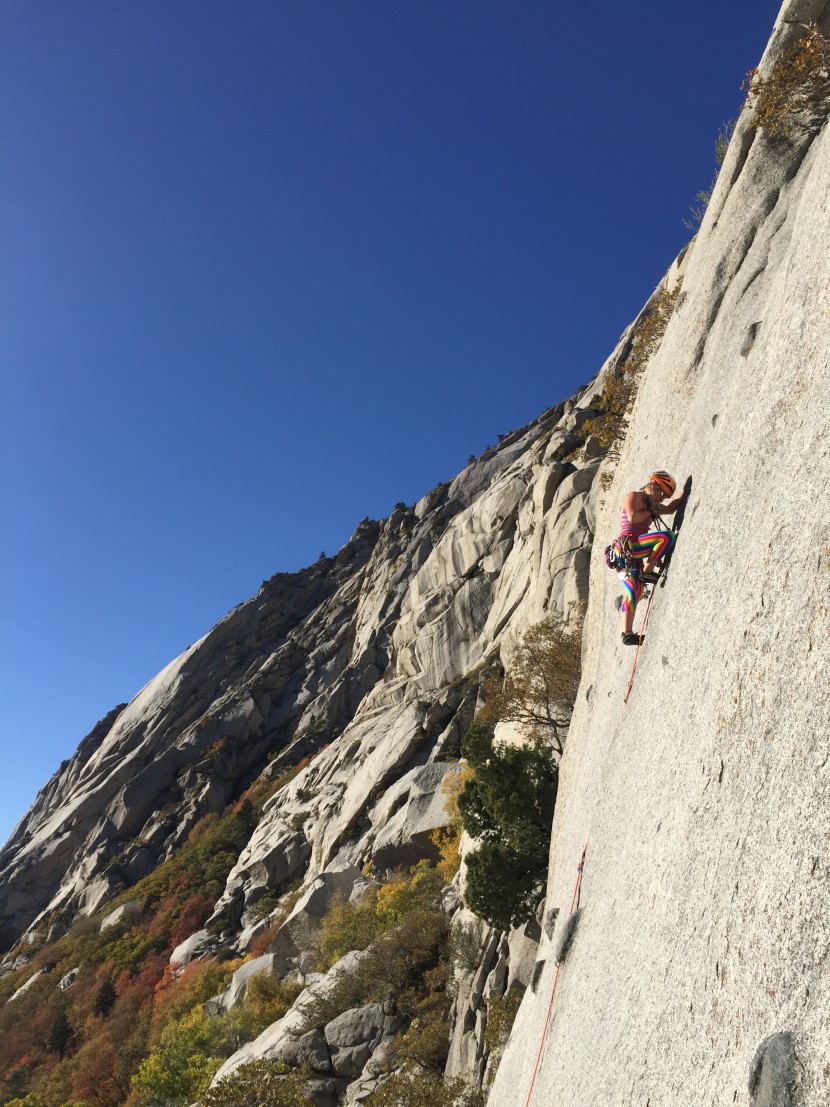
I went to a physical therapist the next day to get his opinion, he thought that I had sesamoiditis and recommended treating it as a soft tissue injury-I kept walking on it and trying to do what I wanted to do. After almost two months of energy sapping pain, I finally went to a doctor. I got an x-ray and, sure enough, the sesamoid bone in my foot was fractured.
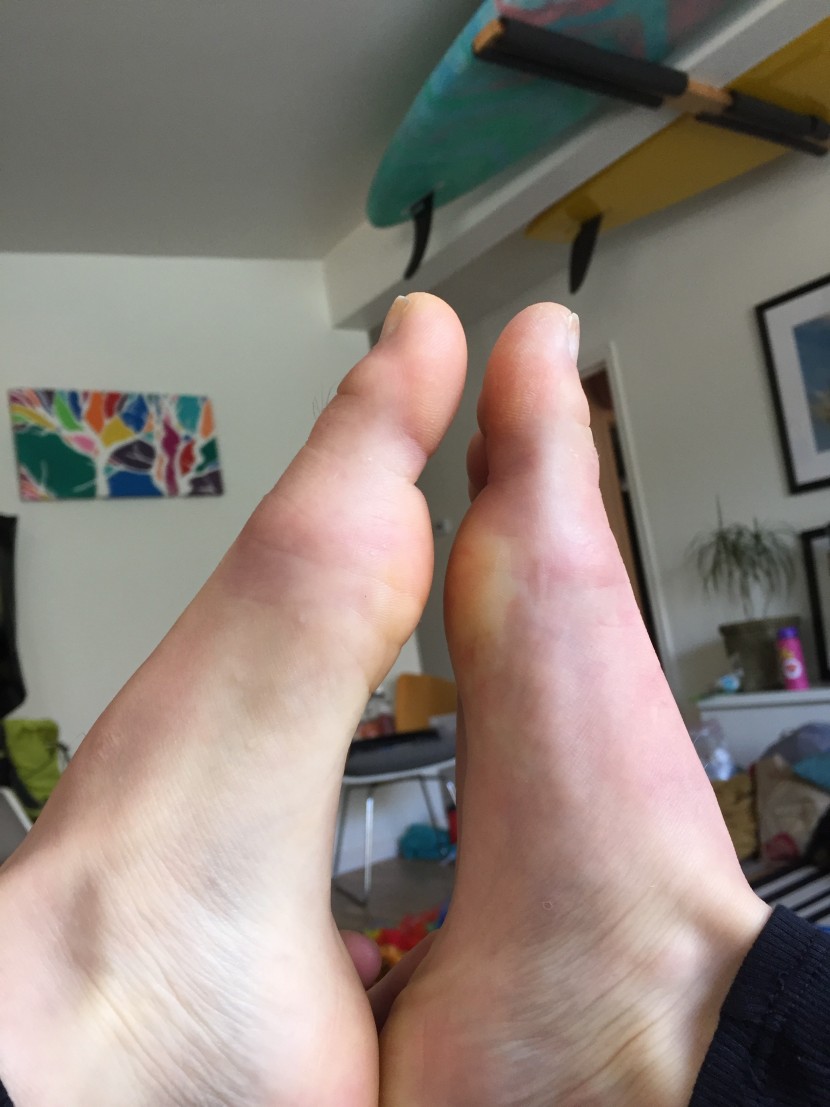
Swollen Left foot.
 broken sesamoid 🙁
broken sesamoid 🙁
The sesamoid bone sits on the bottom of the foot under the big toe and is nestled inside the tendon that goes from the toe to the heel. Basically, the ball of my foot broke. Every single step puts huge forces through this teeny-tiny bone. It, undeniably, takes the spring out of your step, but, even standing is painful. Walking is tormenting. Climbing stairs feels endless. Looking down an airport hallway seems like a marathon distance. Every time I would push off my big toe, the bone would stretch apart or rebreak a little. For that reason, and because that part of the foot gets very little bloodflow, it’s a difficult bone for the body to heal.
I have pondered why it took me so long to get it checked out with an x-ray-I think that it harps back to not wanting to admit that I had an injury. I felt that somehow my whole life, my career, my friendships, my goals, my aspirations, my passion – everything has been built around my ability to walk and run and climb in the mountains! After the x-ray, I spent about 6 weeks in a walking boot, only swimming and riding the stationary bike and limiting time on my feet and still not wanting to disclose an injury to anyone other than my close family and friends.
I’m super grateful to my boyfriend, Rob Lea, a former world champion triathlete, for teaching me how to swim. This was a game changer. As soon as I embraced swimming, life got better. He’s the best coach, and swimming together gave me the chance to have the closeness that we have had climbing, hiking and running together. I have to exercise, and swimming became my solution.
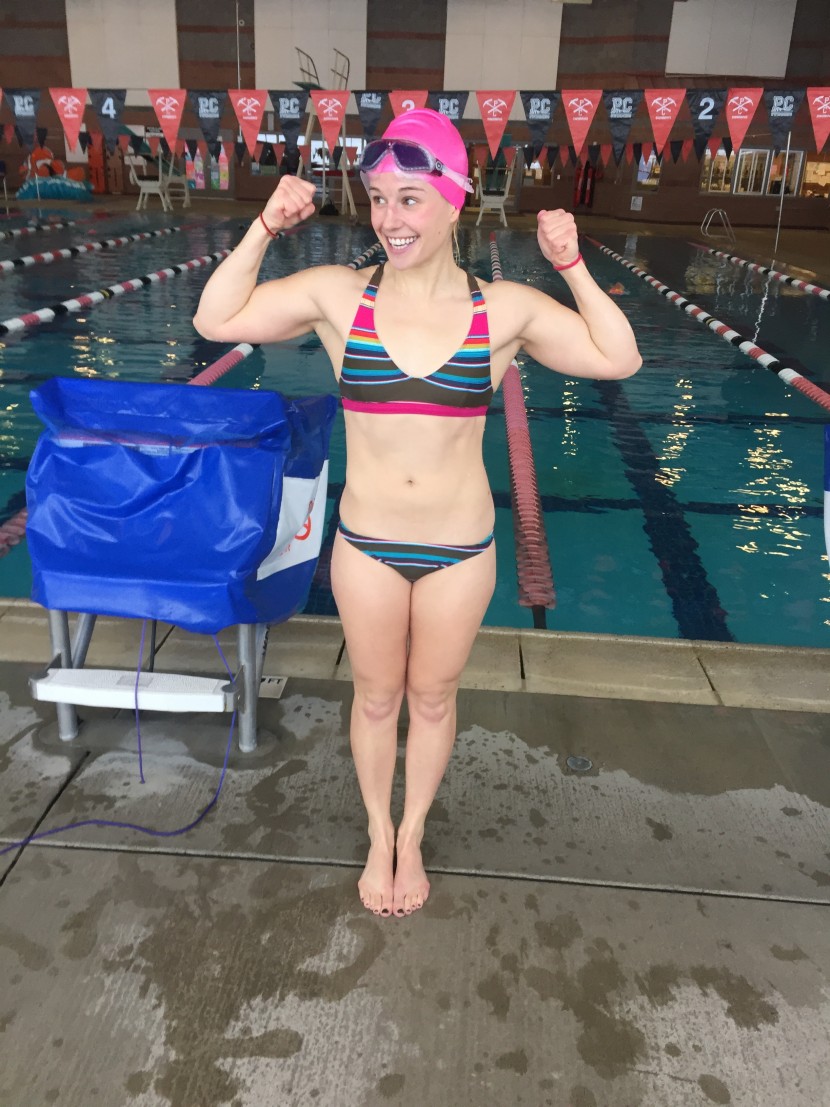
All smiles after accomplishing a mile swim, one of my 2016 goals, early in January! And trying not to be too depressed about not skiing…
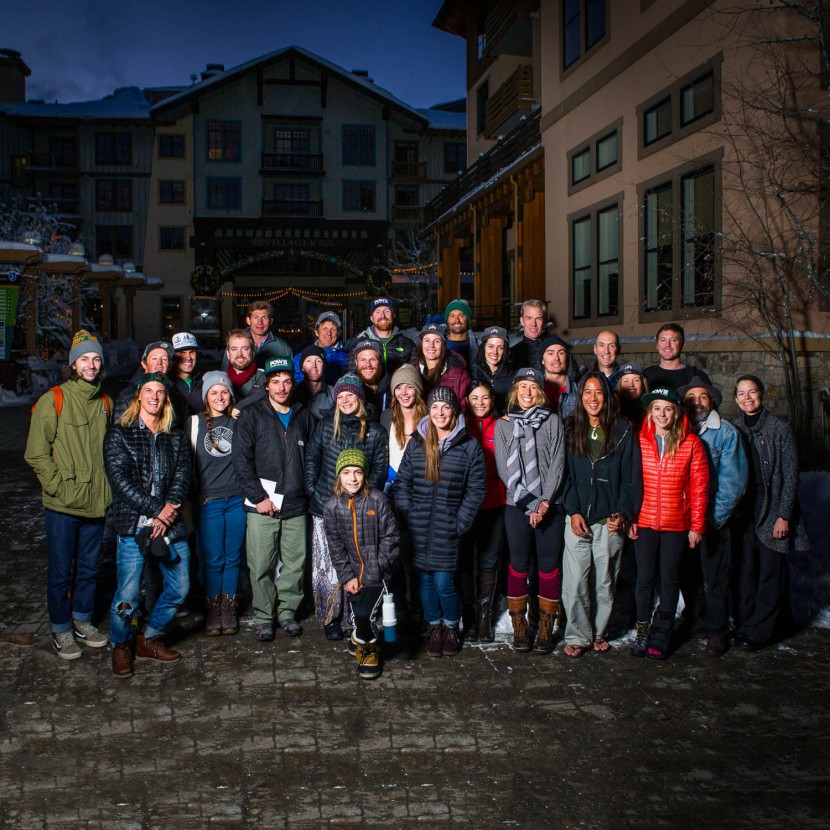
Note my walking boot! I wanted to post this picture, but the injury was still too fresh for me to be able to talk about.
As the powder started to fly, it got harder to stay off my feet. But I had my eyes on the longer-term prize of being able to ski in the spring. My doctor and PT told me to modify activities, modify orthodics and shoes, adn let pain be my guide. They said I could ease into skiing as pain levels permitted.
So I started slowly, first just spending an hour in my ski boots, then longer. Then, I started slowly easing back into longer days. Ski touring, with its rockered ski boots and soft snow surface, proved to be ok on the foot. Some days would still be painful, but the pain was a more manageable level. It still breaks my heart to not be able to climb and run like I want to, but I’m trying to swallow that frog and focus on other areas I can excel.
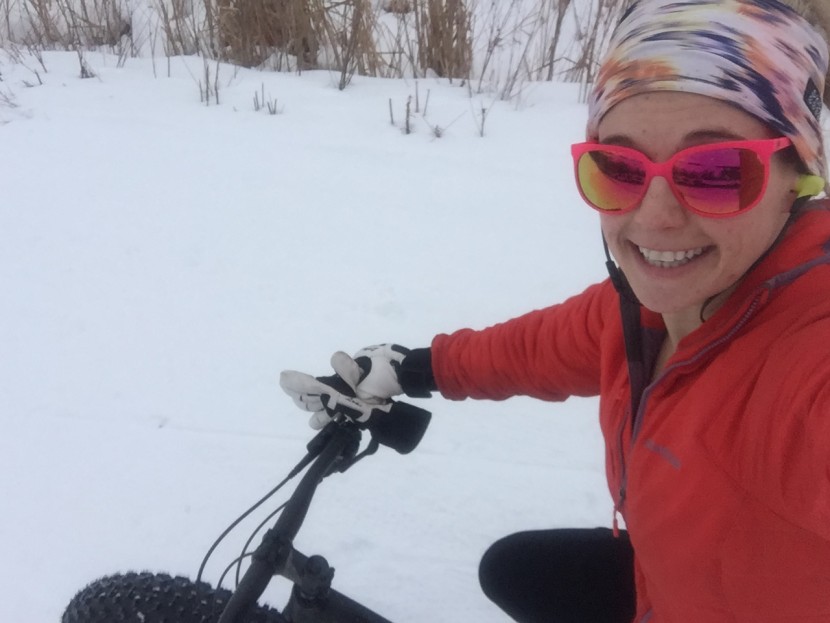
stoked to be on a bike with dirt all over my face!
By mid February, I was able to ski my first couloir. After that, I was able to ski a number of steep lines in the Wasatch this winter and work on several photo and video projects. I set a new goal to swim a mile in 2016 (which I completed in early January), and a summer goal to ride a century on a road bike. I read forums about people with this injury and some say it takes months, even a year, to heal. I want my foot to have a full recovery, so I’m planning to be conservative this summer and take it day by day and focus on biking and swimming. The pain is a nuisance, but overall, I’m grateful for good health.
I’m striving to be like a Jade plant. When you break off a branch of a Jade plant, it regrows in another unexpected place. I realize now how precious long days in the backcountry are, and I treasure them immensely. I’m learning that an athletic career isn’t defined by the setbacks, but how you react to, adapt and overcome those challenges. I’m keeping a positive mindset, and it’s very healing for me to be able to write about this now. I’m not going to lie. There have been moments over the past few months where I have been nearly despondent, worrying that I’ll never be the athlete I once was. There’s been a great deal of mental and physical discomfort with this injury, but I’m also working to find growth and progression– the opportunity to add something else to what I am. A biker, a swimmer. Maybe a future triathlete? Maybe I’ll learn aid climbing! I’m still in love with mountaineering, skiing and living in the mountains. But my body and life are telling me to step back and make sure my body is healthy. Activities like swimming, biking and maybe triathlon are ways to keep the inspiration going and fitness high. In the end, my heart and soul will always be in the mountains. If my big mountain dreams were easy, they wouldn’t be as satisfying. In the short term, my mind and body need other types of rejuvenation.
It’s hard to live up to personal and professional expectations. Fitness goals take years to reach. Setbacks are normal and OK. One thing I haven’t talked about yet: the culture that congratulates people for over-extending. Social media can make it seem like everyone is a super human, never needing any rest. It’s truly incredibly what the human body is capable of, but it has limits. We are not machines. Let’s learn to recognize and talk about the disease of over-extending. There’s a healthy way to train and recover but it’s easy to push it too hard. Endurance training in any sport can be like a drug. The athletes that have the longest, most successful careers will be the ones who learn how to use the adrenaline and endorphins and other brain chemicals responsibly.
I asked my mom where she got the swallowing frogs expression from. One of her friends told it to her. Everyday, she wakes up and realizes she’s going to have to swallow some frogs, but then she can face the day better. Admit that there are some irritating impediments, but don’t let them get you down. Get over them and move on. It’s not the year I envisioned for myself, but I’m having a ball nevertheless and pushing myself in other ways. I’m learning new ways to prepare those frogs (grilled frogs legs anyone? How about we marinate them?) and am actually starting to enjoy the taste of frogs everyday!

Heal up little Sesamoid!
